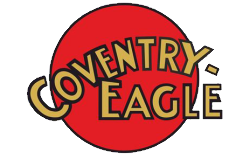


Broadside view of the single-geared model which will be sold fully equipped, as shown, with the addition of a chain guard but without discs.
Showing the clean engine design, the "streamlined " silencer, and the standard position for the Lucas generator.
This sketch illustrates the finned primary exhaust pipe, and also the cradle frame lugs.
A REFINED SPORTING MOUNT.
A New o.h.v. Coventry-Eagle Lightweight.
Now that 250 c.c. lightweights so often attain the once- magic figure of 50 m.p.h. in speed events, it is not surprising that it should strike somebody that there is a market for what may be called a de luxe, vitesse baby machine, to be guaranteed capable of reaching the mile-a-minute gait.
Such a machine is now being introduced by the Coventry Eagle Motor Cycle Co., Ltd., Coventry, and the designer, Mr. P. C. Mayo, has been guided by the same general principles as he used when evolving a growingly successful British sporting big twin, to which the latest production bears some detail resemblance.
Price will not be Excessive.
While no attempt has been made to build the new lightweight down to a price - it possesses an almost regardless of cost finish - it is not expected that the price will be prohibitive ; indeed, £85 is mentioned as a tentative figure for the two-speed model.
Turning to details, it is quite impossible to describe the exact shape of the distinctive dull black saddle tank, beyond saying that no photographs can fully convey just how attractive it is. It holds over two gallons, and feeds the Amac two-lever carburetter by a separate pipe from each compartment. One tap only, therefore, need be turned on, the other half of the tank acting as a spare petrol container.
The frame is neat and strong, and distinctive because of the way in which the cradle engine plates form integral lugs with the down tubes. Modified Brampton forks, with solid links substituted for the horizontal coils, are fitted, and here, again, lugs are cast for the Webb front brake mounting and a special bracket for the baby Lucas head lamp (which will be supplied with each machine).
Braking Arrangements.
At present the rear brake is of the simple heel-operated dummy belt rim type, but later it is proposed to embody a Webb internal expanding brake in the rear wheel.
Although the engine is a proprietary unit a 70x64.5 mm. (249 c.c.) o.h.v. J. A. P. it has so many points of interest, some of them modifications by the present designer, that we have reserved its description to the last. Externally, the most striking point must be the exhaust arrangements. To design a clean and neat passage for the gases on an o.h.v. engine is not an easy task : in this case the difficulties have been overcome in an admirable way. A finned aluminium casting, projecting well out into the oncoming air draught, and of at least 1½ in. internal diameter, acts virtually as a primary expansion chamber. Then a short length of plated pipe extends down to the large streamlined aluminium silencer, another large bore tail pipe reaching well beyond the bottom bracket and ejecting the gases outwardly instead of directly to the rear.
The engine is an exceptionally nice-looking design, and besides the special "buffed" finish of the crank case, it embodies several departures from standard J, A. P. practice. Double taper valve springs are employed, internal coned washers and taper split bushes gripping the valve stems in such a manner that the cotter pins become merely a safeguard. Hardened steel rockers are fitted, and the valve-operating mechanism has been refined in one or two other details.
Transmission.
Single all-chain drive, by means of double roller Coventry chain, is employed in the present model, but it is intended to introduce a two-speed countershaft machine at once, and possibly a mode with the new lightweight Sturmey three speed box in the future.
The Motor Cycle August 11th, 1921
Sources: The Motor Cycle
See also: Coventry Eagle 1920s